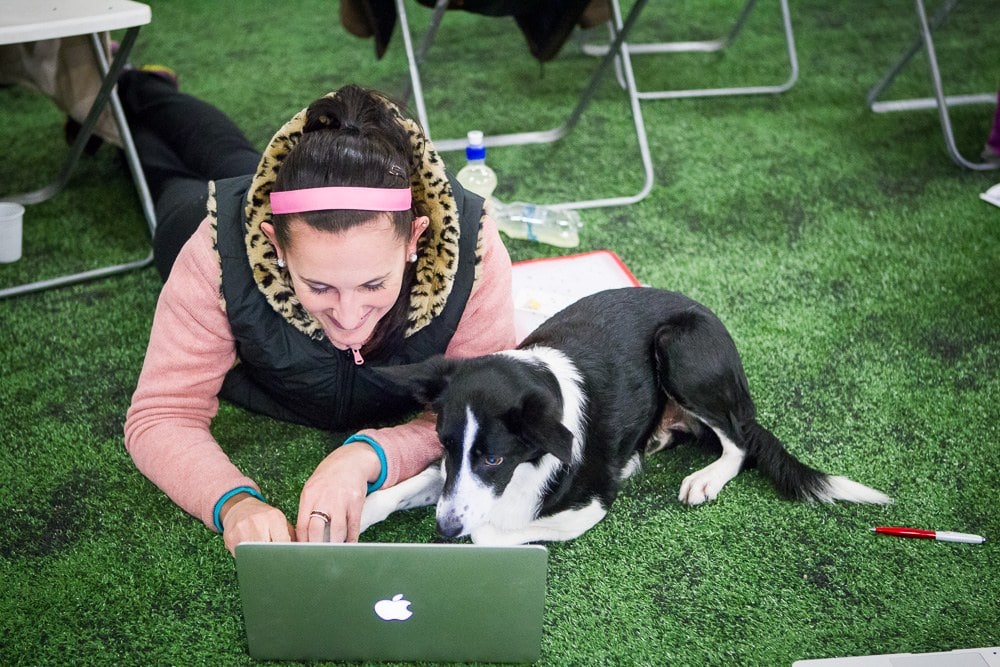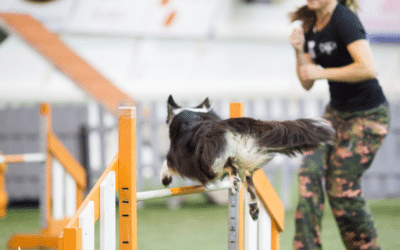Most people don’t start agility training with the aim to be world champion — or even compete, for that matter. But as many of us know, once you start agility and see how much your dog (and you) love it, it sure is addictive, and the path to your first competition is a quick one.
The more you train and progress, the more that desire and hunger to improve starts to increase. So you go to more classes, focus on building your skills and find yourself completely absorbed in all things agility.
But what if you’re not seeing the results you expect to see with the effort you’re putting in?
It’s likely not your performance in class, but the things you do (or don’t do) outside of training that could use some tweaking.
Setting goals in agility: how does it work?
When you’re doing a regular, human-only sport (think tennis, martial arts, weight lifting, whatever) you’re mainly setting goals for yourself — because you’re the only variable you can completely control.
And even then, you might just have an ‘off day’, feel stressed, unwell, or uninterested in working toward a specific goal that session.
With agility training, there’s a dog and a human working together — so how do you set your goals then?
Well, at the end of the day, it’s important to remember that we’re working with dogs. Dogs don’t understand the concept of long-term goals. They live in the moment, and they don’t plan ahead. They want to do what’s fun and enjoyable, learn new things, and get awesome rewards for it.
It’s important that we consider how much you can really train. We can’t always keep training until we get it right, because that wouldn’t be fair for the dog. They get tired, both mentally and physically, and training with a tired dog can easily lead to injuries.
So of course, this means that it’s down to you as the handler to make sure that your dog is happy, healthy and enjoying their training, while achieving the goals you set for yourself.
The goals you set for yourself are supposed to challenge you, and inspire you in your training. On the other hand, if you aim too high, you will probably get frustrated quite quickly — and this will have an impact on your dog’s performance too.
In their article “Keys To Success”, the leading OneMind Dogs coaches Janita Leinonen and Jaakko Suoknuuti point out an important fact: “You need to set your goals high, but they must be realistic, and you need to acknowledge your own – and your dog’s – characteristics.”
So what kind of agility training goals are realistic?
Having broad, aspirational goals as your agility ‘North Star’ can be helpful for keeping you pointed in the right direction (like “I want to place in competitions at the National level”, or “I want to run clean with my dog XX% of the time”).
However, at OneMind Dogs, we’re big fans of living in the moment — at least in the short term. You can’t predict what ‘gaps’ you might notice in a training session, and you don’t know what your dog will need on any particular day.
OneMind Dogs founder and method creator, Janita, often says that her training session can start from one thing and then she’ll end up teaching the dog something entirely different, because the dog shows her what they need to train today.
This means you might not be able to hit a super specific goal in one session — but you end up totally nailing something else.
Basically, it’s all about listening to the dog.
If there is something specific you’d like to learn, breaking it down into small pieces is a helpful way to get to that destination. For example, I’d like to learn how to do a Rear Cross. To get there, I’d make a checklist of all of the skills my dog and I need to be able to do, and check them off as I do them — whether they’re in the same session, or over the span of a few weeks/months.
Some examples of some agility training goals our coaches and students could set for day-to-day training:
Today, I’m going to focus on…
- Keeping connection with my dog
- Getting to correct positions on the course
- Rewarding my dog for following my handling
A practical solution: keeping a training diary
What could be a more practical, and useful solution is as simple as keeping a training diary.
And not just your basic ‘I did this, this and this today’ type of diary, but a place where you document:
- What you actually learned from that session
- Which specific things you need to improve on
- How you felt (mentally, physically) during that session, and how it might have impacted the outcomes
- How your dog reacted to different situations, and why
If you’ve ever been to a training session or seminar by Janita Leinonen, she ends each session by asking her students to answer questions like “What do you need to remember from this session?” and “What did you do correctly that made your dog do xyz?”, or “What do you need to work on to do that sequence correctly?”
This type of questioning is called active recall, and it’s proven to embed knowledge significantly better than simply writing things down, reading or passively consuming information — and you can easily practice active recall by yourself.
A helpful exercise you can do is write instructions to yourself, as if you were explaining it to someone else. This will help you apply the knowledge in similar situations later. Also, the more concrete and clear your advice is, the easier it’ll be to remember later.
Most importantly, use positive words when using your agility training diary — leave out words like “no” and “don’t”, and instead focus on what you need to do.
For example, you could write down something like
“With Kevin, if I need him to turn tightly from a curved tunnel, I need to be closer to the entrance of the tunnel than the exit when he enters”
“Kevin can finish the weaves even though I cross his line at the beginning of the weaves if I keep my eyes on him and support him with my chest laser”
And at the end of the day, you can come back to these points later to see how your mindset and skills have improved.
A simple, digital way to keep your training diary
If you’re an analog kind of person, you could keep your training diary in a simple paper notebook.
However, a simpler way to keep track of your training (and more) is to opt for a digital solution.
AgiNotes is an online training diary designed specifically for agility. It helps you focus on your dog’s individual needs and celebrate the small wins. This way, you’ll take steps towards the best version of you two as a team.
It’s designed to make training more successful by helping you focus on the right things and plan your training more effectively. You can track your progress, rate your training sessions and best of all, it’s offered in several languages.
Cool, right? Check out AgiNotes below.



